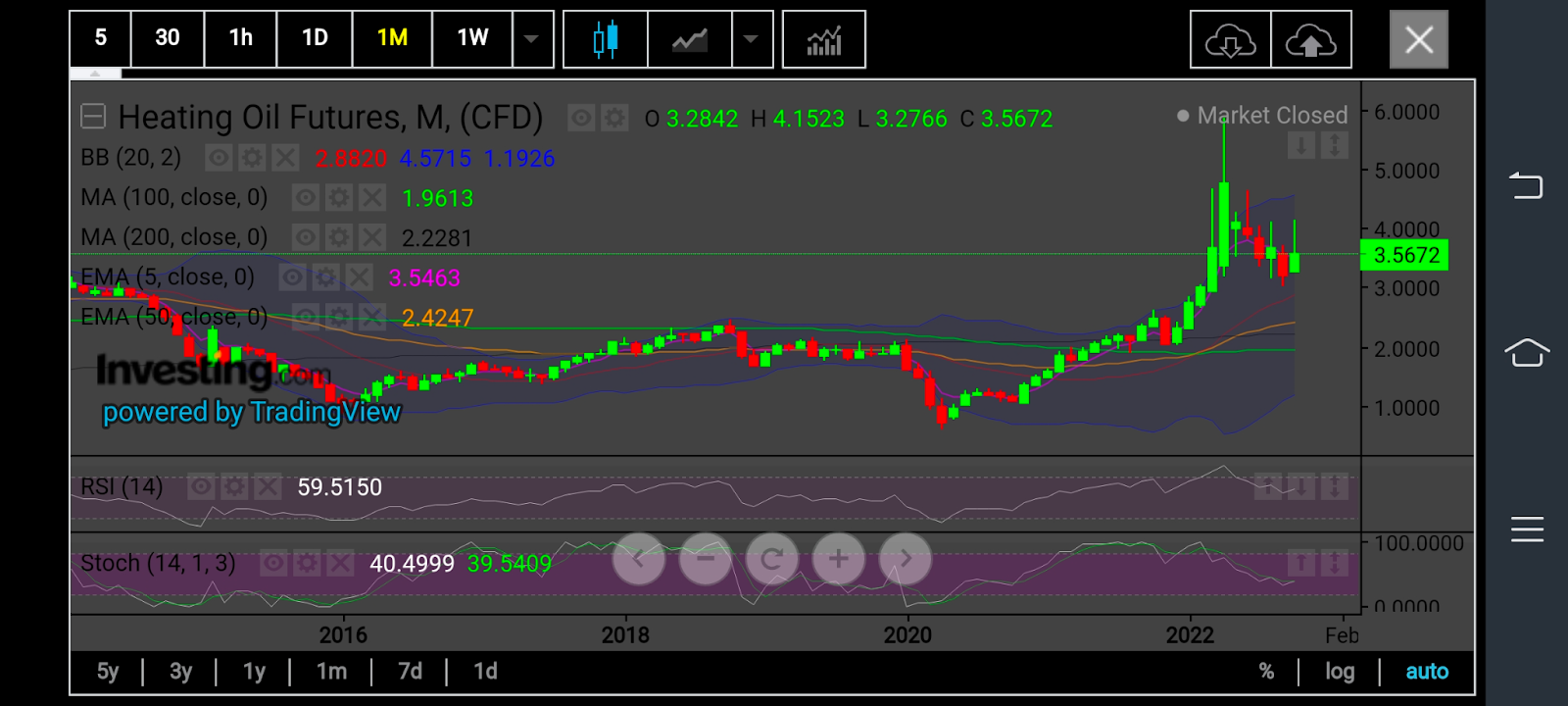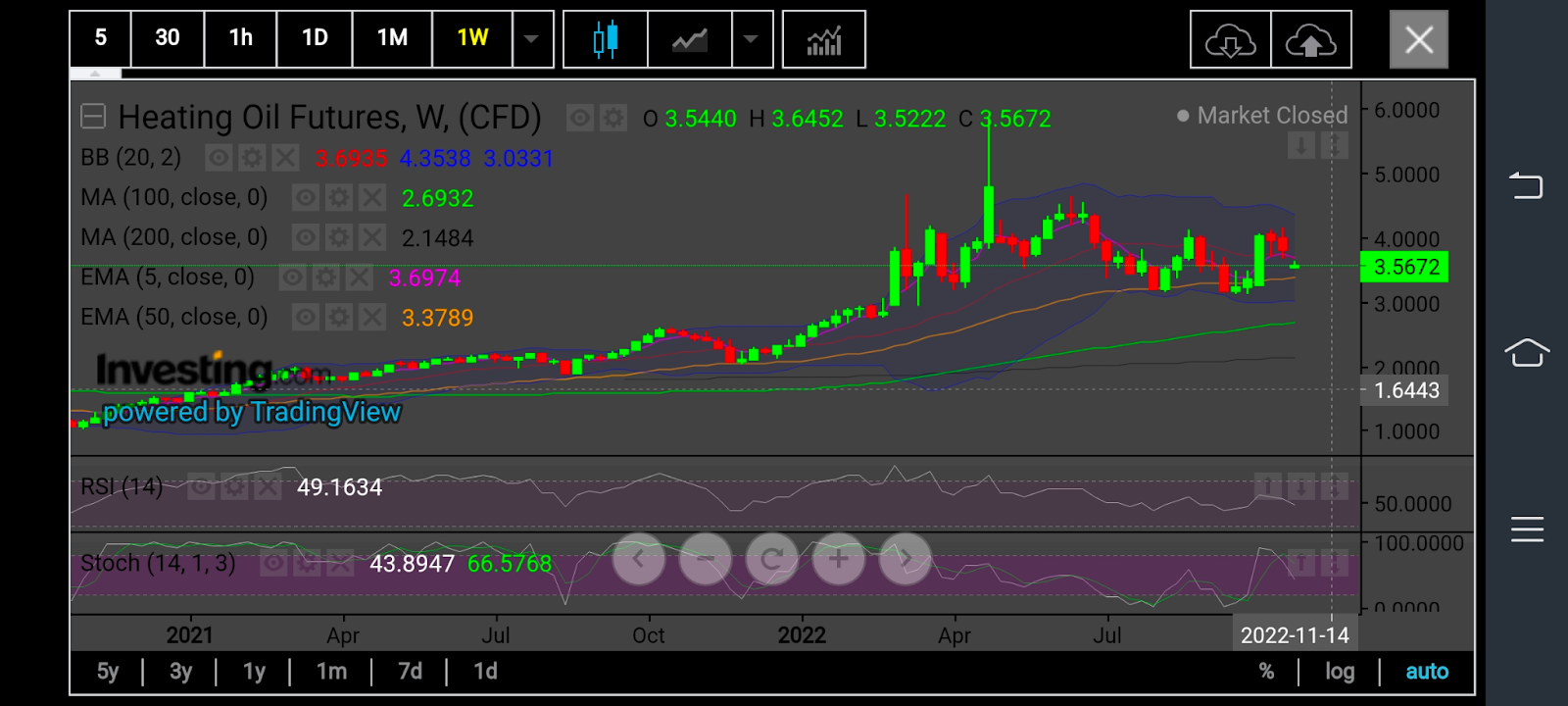- Heating oil down 11% from the week ended Sept. 30 through Oct. 21
- Plunge came as first distillate stockpile build in 4 weeks met warm weather
- Charts indicate drop to $3.39 and below if next distillate data disappoints
US heating oil prices have plunged 11% over the past three weeks after the first stockpile build in four weeks for the commodity—unusual at this time of the year when prices should actually be running higher in the runup to winter.
To be sure, at the time of writing, heating oil futures on the New York Mercantile Exchange—alternatively known as ultra-low-sulfur distillates or just distillates—showed an annual gain of almost 55%. Distillates don’t just produce heating oil; they are also refined into the diesel needed for trucks, buses, trains and maritime vessels, as well as the fuel for jets.
Despite their diversity in use, the bulk of heating oil’s annual price gain now is a carry-forward of the supply hype from March, when fears of a run-out of the commodity in the aftermath of the Ukraine war sent the heating oil rally to record highs.

Charts by SKCharting.com, with data powered by Investing.com
The reality since is that the supply situation in heating oil hasn’t really matched the pitch those fears were initially voiced at. This is similar to the dynamics revolving around natural gas, where a global cat-and-mouse game of the highest stakes is being played by the Russians versus the West over the use of a commodity as a weapon or wartime bargaining chip.
Heating oil futures hit a three-week low of $3.52 per gallon in Monday’s trading session after the surprise distillate build of 124,000 barrels announced by US Energy Information Administration (EIA) for the week to Oct. 14 coincided with unseasonably warm temperatures for mid-to-late October.
Industry analysts tracked by Investing.com had bet on a stockpile drop of 2.17 million barrels for the week to Oct. 14, to add to the phenomenal drawdown totaling more than 11 million barrels over three prior weeks.
Those three consecutive weeks of drawdowns in distillate inventories came as US refiners took advantage of high-profit margins to export to Europe, which needs diesel and heating oil.
John Kilduff, partner at New York energy hedge fund Again Capital, said:
“When that trend suddenly stopped in the most recent week, the natural question on everyone’s mind was: Has the game suddenly changed for distillate exports? Probably not is the answer. But until we see the next EIA data confirming the continuance of the export trend or unless the weather turns much colder suddenly, it’s safe to say distillates will be, for now, the weakest link on the petroleum complex.”
Historically, heating oil reached an all-time high of $5.86 in April.
Also known as No. 2 fuel oil, heating oil accounts for about 25% of the yield of a barrel of crude, the second largest "cut" after gasoline. The heating oil futures contract trades in units of 42,000 gallons (1,000 barrels) and is based on delivery in New York harbor, the principal cash market trading center. The heating oil futures contract is also used to hedge diesel fuel and jet fuel, both of which trade in the cash market at an often stable premium to NYMEX Division New York harbor heating oil futures.
While futures of heating oil had tumbled over 11% in the course of three weeks, the EIA projected earlier this month that US consumers can expect to pay up to 28% more to heat their homes for the 2022/23 winter versus 2021/22 due to surging fuel costs and a slightly colder weather.
This is despite OPEC+’s prediction that oil demand will soften in the next few months, thanks to economic headwinds. OPEC's monthly oil market report for October sounded a pessimistic note about global economic growth. And because economic growth drives oil demand, the group reduced its projections for growth in global oil consumption by 500,000 barrels per day, or more than 15%.
The EIA, however, said that nearly half of US households rely on natural gas for heat, with the average winter heating cost expected to rise to $931, up by 28% from last year.
The average cost to heat a home with gas last winter was $724, far cheaper than other major sources of heat, the EIA said in a report carried by Reuters.
US gas prices at the Henry Hub benchmark were up about 75% this year as soaring global prices feed demand for US exports due to supply disruptions and sanctions linked to Russia's Feb. 24 invasion of Ukraine.
Electricity is the primary heating source for about 40% of homes. It is more expensive than gas at an estimated $1,359 per household this winter—but that is just a 10% increase from last winter.
Less than 12 million homes rely on heating oil or propane—about 9% of the roughly 130 million US households—but those fuels will remain the most expensive sources of heat this winter with cost increases of 27% to $2,354 for heating oil and 5% to $1,668 for propane.
Homes that rely on heating oil are concentrated in the Northeast, while the biggest propane users are in the Midwest.
EIA said residential costs will rise to $15.95 per thousand cubic feet (mcf) for gas, $2.32-$3.45 per gallon for propane, 14.8 cents per kilowatt-hour (kwh) of electricity and $4.54 per gallon for heating oil.
That compares with last winter's residential costs of $13.02/mcf for gas, $2.30-3.33 per gallon for propane, 14.0 cents per kWh of electricity and $3.90 per gallon for heating oil.
As such, heating oil itself is expected to trade at $4 per gallon by the end of this quarter, according to Trading Economics’s global macro models and analysts' expectations. The trading house has also made an ambitious $4.56 call for heating oil in 12 months’ time.
So, if the EIA reports another lackluster number for distillate inventories this week, where could heating oil prices go?

The weekly price action in heating oil “remains sideways,” with an initial bearish bias and moving to retest the 50-week Exponential Moving Average of $3.39, said Sunil Kumar Dixit, chief technical strategist at SKCharting.com. He added:
“The recent runaway gap down may be followed by more declines towards $3.38 and eventually bouncing back towards $3.67 and $3.77.
“Any major bullish rally can occur only after a strong break above $4.15 on the horizontal resistance zone.”

On the upside, the short-term sideways movement was capable of striking $4.15, Dixit said, adding that the monthly Relative Strength Indicator reading of 59 was well above neutral, while the Stochastics reading of 40/39 was positive.
Disclaimer: Barani Krishnan uses a range of views outside his own to bring diversity to his analysis of any market. For neutrality, he sometimes presents contrarian views and market variables. He does not hold positions in the commodities and securities he writes about.
